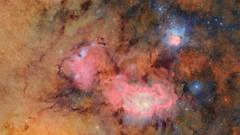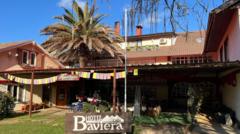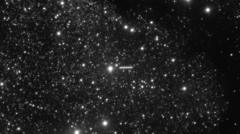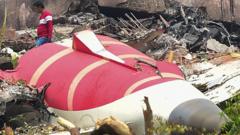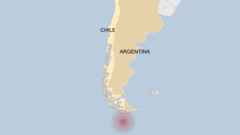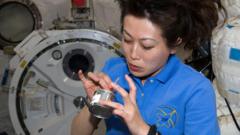The first celestial image from the Vera Rubin Observatory in Chile has been released, showcasing the Trifid and Lagoon nebulae in remarkable detail. This state-of-the-art telescope is equipped with the world's most powerful digital camera, enabling it to explore the far reaches of space like never before. The image highlights vibrant gas and dust clouds in a star-forming region located 9,000 light years from Earth.
The Vera Rubin Observatory promises to revolutionize our comprehension of the cosmos by searching for potential planets, identifying hazardous asteroids close to Earth, and mapping the Milky Way. It aims to unravel the mysteries of dark matter, composed mostly of unknown substances. This telescope's critical ten-year mission will ensure continuous observation of the southern night sky, noted as a landmark moment for modern astronomy.
“We have been preparing for this milestone for about 25 years. This incredible facility will enable us to conduct unprecedented surveys of our sky,” stated Professor Catherine Heymans, Astronomer Royal for Scotland. The UK plays a vital role in the project, contributing to the data processing required to analyze the high-resolution images. Estimates suggest Vera Rubin could increase the number of identified objects in our solar system dramatically.
Perched on Cerro Pachón in the Andes, the observatory enjoys a prime location for stargazing due to its height, dryness, and minimal light pollution. Stringent measures are in place to maintain optimal darkness within the facility, ensuring the purity of the astronomical observations. The dome surrounding the telescope is designed to eliminate any stray lights that might disrupt the capturing of celestial images.
With its unique three-mirror system, the observatory's 3,200-megapixel camera can capture images every 40 seconds for up to 12 hours a night. It is built to reveal the faintest cosmic signals, including light from ancient supernovae and distant galaxies. The telescope is expected to provide fresh insights into the formation of the universe, dark matter, and even the possible existence of a ninth planet in our solar system.
The ambition of the Vera Rubin Observatory is exceptionally high, as it aims to analyze around 10 million notifications nightly. Its innovative approach to surveying the universe, especially in detecting changes and transient celestial events, could lead to groundbreaking discoveries. “This observatory has the potential to reveal phenomena previously unknown to us,” remarked Professor Heymans.
As scientists prepare for this influx of data, the potential for significant advancements in our understanding of the cosmos seems limitless. Many anticipate that this project will yield vast insights into the boundaries of galaxies and details about the Milky Way, finally shedding light on longstanding astronomical mysteries.
The Vera Rubin Observatory's first image heralds a new chapter in our exploration of the universe, bringing humanity closer to answering age-old questions about our existence and the stars above.
The Vera Rubin Observatory promises to revolutionize our comprehension of the cosmos by searching for potential planets, identifying hazardous asteroids close to Earth, and mapping the Milky Way. It aims to unravel the mysteries of dark matter, composed mostly of unknown substances. This telescope's critical ten-year mission will ensure continuous observation of the southern night sky, noted as a landmark moment for modern astronomy.
“We have been preparing for this milestone for about 25 years. This incredible facility will enable us to conduct unprecedented surveys of our sky,” stated Professor Catherine Heymans, Astronomer Royal for Scotland. The UK plays a vital role in the project, contributing to the data processing required to analyze the high-resolution images. Estimates suggest Vera Rubin could increase the number of identified objects in our solar system dramatically.
Perched on Cerro Pachón in the Andes, the observatory enjoys a prime location for stargazing due to its height, dryness, and minimal light pollution. Stringent measures are in place to maintain optimal darkness within the facility, ensuring the purity of the astronomical observations. The dome surrounding the telescope is designed to eliminate any stray lights that might disrupt the capturing of celestial images.
With its unique three-mirror system, the observatory's 3,200-megapixel camera can capture images every 40 seconds for up to 12 hours a night. It is built to reveal the faintest cosmic signals, including light from ancient supernovae and distant galaxies. The telescope is expected to provide fresh insights into the formation of the universe, dark matter, and even the possible existence of a ninth planet in our solar system.
The ambition of the Vera Rubin Observatory is exceptionally high, as it aims to analyze around 10 million notifications nightly. Its innovative approach to surveying the universe, especially in detecting changes and transient celestial events, could lead to groundbreaking discoveries. “This observatory has the potential to reveal phenomena previously unknown to us,” remarked Professor Heymans.
As scientists prepare for this influx of data, the potential for significant advancements in our understanding of the cosmos seems limitless. Many anticipate that this project will yield vast insights into the boundaries of galaxies and details about the Milky Way, finally shedding light on longstanding astronomical mysteries.
The Vera Rubin Observatory's first image heralds a new chapter in our exploration of the universe, bringing humanity closer to answering age-old questions about our existence and the stars above.

